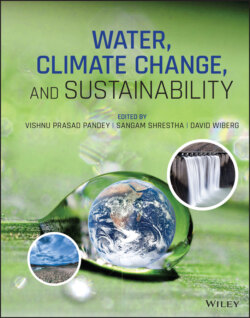Читать книгу Water, Climate Change, and Sustainability - Группа авторов - Страница 14
1.1 SUSTAINABILITY CHALLENGES AND GLOBAL INITIATIVES
ОглавлениеPopulation growth, land use/cover change, unsustainable consumption patterns, desertification, urbanization, biodiversity loss and climate change are among the key global challenges that are impacting humans and the ecosystem in various ways. They are putting stress on our planet’s resources and threatening the very sustainability of livelihood support systems. With increased population, urbanization, and change in lifestyles and dietary systems, we are increasing resource footprints, which are expressed in terms such as water footprint (Chapagain and Hoekstra 2004), ecological footprint (Walther et al. 2005), and energy footprint and/or carbon footprint (Sovacool and Brown 2010; Pradhan et al. 2013; Pradhan and Kropp 2020). Our actions are exerting more stress on the Earth’s natural resources and the Earth has its own planetary boundaries (Steffen et al. 2015). Therefore, for addressing the sustainable development challenges, we need coordinated actions at global, regional, and local levels under various sectors, in particular, water and climate change.
Understanding the aforementioned needs and efforts to that end itself is not new. The Stockholm Convention in 1972 is the first international conference on environmental issues which became a turning point for international environmental politics (Table 1.1). The United Nations Conference on Water held in Mar del Plata, Argentina in 1977 is of significance in the water and environment sector as it approved the Mar del Plata Action Plan, which was the first internationally coordinated approach to the integrated water resources management (IWRM) (Biswas 2004). Since then, a number of notable global commitments and initiatives were agreed and implemented as the global goals. They include but not limited to Agenda 21 and Convention on Biological Diversity (CBD) which was agreed on the 1st Earth Summit held in Rio de Janerio in 1992; establishment of intergovernmental institutions such as Intergovernmental Panel on Climate Change (IPCC) established jointly by the World Meteorological Organization (WMO) and the United Nations Environment Programme (UNEP) in 1988; Kyoto Protocol on curbing greenhouse gas emissions agreed in 1997 and came into effect from 2005; Millennium Development Goals (MDGs) agreed in the UN Millennium Summit in 2000; establishment of Intergovernmental Science‐Policy Platform on Biodiversity and Ecosystem Services (IPBES) in 2012; Hyogo Framework for Action (HFA, 2005) for building resilience of nations and communities, Sendai Framework on Disaster Risk Reduction (SFDRR 2015); 2030 Sustainable Development Agenda and Sustainable Development Goals (SDGs) agreed in 2015 by the UN General Assembly; and Paris Agreement adopted by the parties of United Nations Framework Convention on Climate Change (UNFCCC) in COP21, held in 2015 in Paris (Table 1.1), as the post‐Kyoto Protocol measures for dealing with greenhouse gas (GHG) mitigation, adaptation, and finance; among others.
Of the most recent set of global commitments, Paris Climate Agreement (PCA) and SDGs are highly interconnected to each other and comprehensively cover major domains of sustainability, particularly water sharing, in both breadth and depth (Dzebo et al. 2019). For example, impacts of climate change to various sectors are primarily manifested thorough water and achieving SDGs are hinged at securing water and achieving water‐related targets. Water is not explicitly mentioned in the PCA, however, a closer analysis revels its dependence on adequate water resources to a deeper extent. Adaptation initiatives related to conserving freshwater, coastal water and groundwater are included as the first priority in many nationally determined contributions (NDCs) (UN‐Water, 2019a). As outlined in Table 1.2, water security underpins sustainable development as it shares a close interdependency with multiple sustainability challenges (UN‐Water 2019b). SDGs are the interconnecting system rather than just collection of goals, indicators and targets (Pradhan 2019). Sustainable water management will be crucial in determining whether the world achieves the SDGs and aspirations for reducing poverty and enhancing shared prosperity (World Bank 2016). Therefore, we need solutions that ensures water does not become a constraint on prosperity.
Achievement of SDGs depends on the wise use of the water resources and appropriate climate actions, among others. However, sustainable use, management, and governance of water resources considering multiple sectors (e.g., energy, water, environment, etc.) and dimensions (e.g. social, economic and environment) in the context of climate change is a challenging as well as rewarding endeavor. It is therefore imperative to make the best use of hydro‐ and climate‐sciences and associated tools/techniques for localizing and mainstreaming global commitments such as the 2030‐Agenda (or SDGs), without which realizing the global commitments is less likely. The term “localizing” here refers to customizing the global commitments to local contexts (national and sub‐national levels) in terms of targets and internalizing through adequate provisioning of resources, both financial and human. In this context, this chapter sheds light on the evolution of water and climate as global agenda; formulation and governance of SDGs; linkages between water, climate change, and SDGs; and challenges and opportunities associated with localizing the global commitments. This chapter highlights how the organization of the contents and chapters covered in this book addresses the close connectivity among the three issues, namely, water, climate change, and sustainable development.
